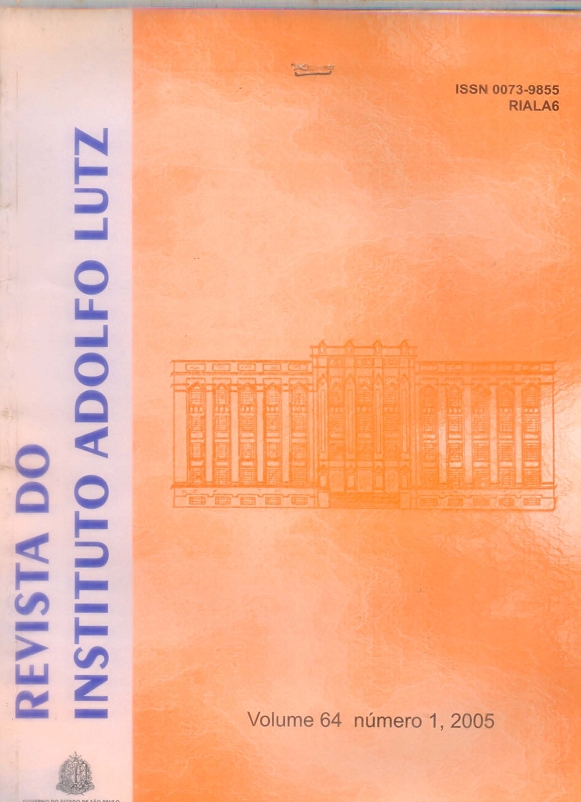Resumen
A qualidade da água de abastecimento público é de grande importância para a saúde da população. A água pode ser um importante veículo de doenças de natureza infecciosa e química. Este trabalho objetivou realizar um estudo da qualidade da água no aspecto microbiológico nos cavaletes, pós-cavalete da rede pública escolar do Município de Ibiúna SP. As condições de limpeza e conservação das caixas d'água foram também avaliadas. O estudo foi realizado durante o segundo semestre de 2004. Foram realizadas 56 amostragens em 28 escolas, sendo 28 do cavalete e 28 no ponto de consumo, para análise laboratorial no aspecto microbiológico. Das 28 amostras no cavalete das escolas, 3,57% apresentaram coliformes totais e E coli. No ponto de consumo, das 28 amostras, 21,42% apresentaram coliformes totais e 14,28%, E coli. A avaliação das caixas d'água mostrou que 57,14% do total estavam insatisfatórias em relação a higiene e conservação. Há necessidade de ações corretivas em todas as etapas de fornecimento de água de uso público.Citas
1. Riedal G, Controle Sanitário dos Alimentos. 2 ed. São Paulo: Atheneu,1992.
2. Numanovic F, Hukic M, Nurkic M, Delibegovic Z, Gegic M, Tihic N. Viruses in drinking water: HAV and enteroviruses. Med Arch 2004; 58:105-8.
3. Tominaga MY, Midio A F. Exposição humana a trialometanos presente sem água tratada. Rev Saúde Pública, 1999;33: 413-21.
4. Isaac- Marquez AP, Lesava Davila CM, Kupech RP, Tamay Segovia P. Calidad sanitaria de los seministros de água para consumo humano em Campeche, Salud Publica Méx 1994; 36: 655-61.
5. Batalha BHL. Água para consumo humano. In: Batalha BHL; Costa TCR, editores. Água, saúde e desinfecção. São Paulo. CETESB, p.7-39, 1994.
6. Freitas VPS, Brígido BM, Badolato M. I. C.; Alaburda J. Padrão físico químico da água de abastecimento público da região de Campinas. Rev. Inst. Adolfo Lutz, 2002; 11: 51-8.
7. São Paulo. Leis, decretos, etc. Resolução SS- 45 de 31 de janeiro de 1992. Institui o programa de vigilância da qualidade da água para o consumo humano- Pró – Água e aprova diretrizes para a sua implantação no âmbito da Secretaria da Saúde. Diário Oficial, 01 de fevereiro de 1992, seção I, p.27.
8. American Public Health Association [Apha]. Standard Methods forthe Examination of Water and Wasterwater. 20Ú ed. 1998.
9. Alves NC, Odorizzi AC, Goulart FC. Análise microbiológica de águas minerais e de água potável de abastecimento, Marília, SP. Rev Saúde Pública, 2002, 36:2.
10. Brooks GF, Butel JS, Morse AS. Microbiologia médica. 20aed. Rio de Janeiro: Guanabara Koogan; 1998. p.175-84.
11. Marçal MC, Antunes GM, Santana GM, Pereira, I. Perfil econômico sanitário da água consumida por empresas, residências e hospitais do Recife. Recife, Fundação Instituto Tecnológico do Estado de Pernambuco, 1994 [Apresentado ao XIV Congresso Brasileiro de Ciência e Tecnologia de Alimentos. São Paulo; 1994].
12. Simpson H. Promoting the management and protection of privatewater well. J Toxicol Environ Health 2004; 67: 1679- 704.
13. Renzetti S, Dupont, D. The performance of municipal water utilities: evidence on the role ownership, J Toxicol Environ Health 2004, 20-22:1861.
14. Amaral LA, Filho AN, Rossi Júnior OD, Ferreira FLA, Barros LSSB. Água de consumo humano como fator de risco à saúde em propriedades rurais. Rev Saúde Pública 2003; 37: 4.
15. Jagals C, Jagals P. Application of HACCP principles as a managementtool for monitoring and controlling microbiological hazards in watertreatment facilities. Wat Sci Techno, 2004,50,1:69-76.
16. Yuksel E, Eroglu V, Sarikaya, HZ, Koyuncu I. Current and futurestrategies for water and wastewater management of Istanbul City. Environ Manage 2004; 33:186-95.
17. Nanan D, White F, Azam I, Afsar H, Hozhabri S. Evaluation of water, sanitation, and hygiene education intervention on diarrhoea innorthern Pakistan. Bull World Health Organization 2003; 81:160-5.
18. Adriaens P, Goovaerts P, Skerlos S, Edwards E, Egli T. Intelligentinfrastructure for sustainable potable water: a round for emergingtrans national research and technology development needs. Biotechnol Adv 2003; 22:119-34.

Esta obra está bajo una licencia internacional Creative Commons Atribución 4.0.
Derechos de autor 2005 Revista del Instituto Adolfo Lutz
